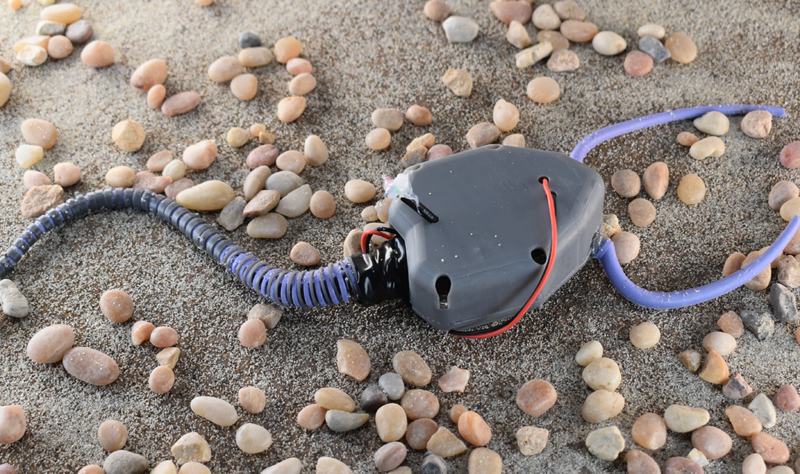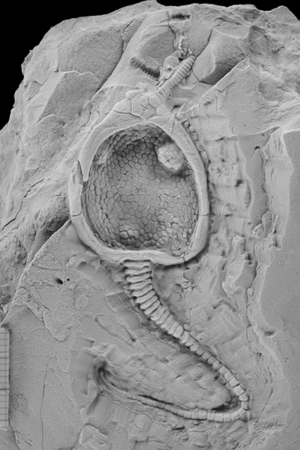
Until now, when scientists and engineers have developed soft robots inspired by organisms, they’ve focused on modern-day living examples. For instance, we previously reported on soft robot applications that mimicked squid, grasshoppers, and cheetahs. For the first time, however, a team of researchers has now combined the principles of soft robotics and paleontology to build a soft-robot version of pleurocystitid, an ancient sea creature that existed 450 million years ago.
Pleurocystitids are related to modern-day echinoderms like starfish and brittle stars. The organism holds great significance in evolution because it is believed to be the first echinoderm that was capable of moving: It employed a muscular stem to move on the sea bed. But, due to a lack of fossil evidence, scientists never clearly understood how the organism actually used the stem to move underwater. “Although its life habits and posture are reasonably well understood, the mechanisms that control the movement of its stem are highly controversial,” authors of a previously published study focusing on the echinoderm stem note.
The newly developed soft-robot replica (also called the “Rhombot”) of a pleurocystitid has allowed researchers to decode the organism’s movement and various other mysteries linked to the evolution of echinoderms. In their study, they also claim that the replica will serve as the foundation of paleobionics, a relatively new field that uses soft robotics and fossil evidence to explore the biomechanical differences among life forms.
Making a soft robot replica
There are many reasons why scientists don’t attempt to make a soft robot version of something extinct and as old as pleurocystitid. It is tricky to understand how the organism moved because there is no modern-day analog. Plus, fossil evidence only provides limited information about how an organism moved. For instance, while some researchers suggest that pleurocystitid swam, others argue that it exhibited sculling or sinusoidal movements.
To overcome these challenges, the researchers worked with paleontologists who specialize in echinoderms. They collected fossil images, CT scans, and all the other evidence they could find and then used this data to design the pleurocystitid’s body and stem. Subsequently, they employed elastomer casting and 3D printing to construct the various parts of the robot based on the design.

When they tried to make the robot move using the stem (like the real pleurocystitid), they were faced with another challenge. “The soft actuator used nitinol wire, a shape memory alloy (SMA) that would often burn out and become permanently stretched. This required making many stems (nearly 100 stems were made) and replacing them when they went bad,” Richard Desatnik, lead researcher and a PhD student at Carnegie Mellon University (CMU), told Ars Technica.
It was also challenging to replicate the soft muscular stem of the pleurocystitids, since the researchers could not use conventional motors, which are too bulky and rigid. “Instead, we needed to use a special ‘artificial muscle’ wire composed of nickel and titanium alloy that contracts in response to electrical stimulation. This allowed us to create a stem-like actuator that matched the flexibility of a natural muscular stem,” Carmel Majidi, senior study author and a professor of mechanical engineering at CMU, added.
The researchers then ran some simulations to see how the Rhombot would likely move underwater. They discovered that a longer stem resulted in better movement. According to the study, this was consistent with fossil evidence suggesting the evolution of longer stems in pleurocystitids over time.
After studying the simulations, the researchers placed the robot in a 42×42-inch fish tank with a bottom surface similar to a seabed. They conducted multiple tests, each lasting two minutes, to examine the robot’s movement. “We demonstrated that wide, sweeping gaits could have been the most effective for these echinoderms and that increasing stem length might have significantly increased velocity with minimal additional energy cost,” the researchers note in their study.
Studying extinct animals
Making functional replicas of extinct ancient creatures using paleobionics sounds pretty interesting, but what can robots tell us that the fossil record can’t? When we posed this question to Majidi, he explained that by only focusing on robots inspired by existing species, scientists may be losing a big opportunity to learn the biological and evolutionary principles that governed the lives of numerous other life forms.
For instance, according to an estimate, modern-day living organisms comprise only 1 percent of all the life that ever existed on Earth. “We can begin to learn from the 99 percent of species that once roamed the earth instead of just the 1 percent. There are plenty of creatures that were successful for millions of years and died out due to drastic changes in their environment,” Majidi told Ars Technica.
Soft robot replicas of such creatures equip paleontologists with a powerful tool to create experimental testbeds for examining hypotheses about how these ancient life forms moved and evolved.
The current study successfully demonstrates that soft robotics can potentially be used to “resurrect” extinct organisms and study their locomotion and biomechanics. “It had never been done before within the soft robotics community, and we hope it inspires more research in the field,” Desatnik added.
PNAS, 2023. DOI: 10.1073/pnas.2306580120 (About DOIs)
Rupendra Brahambhatt is an experienced journalist and filmmaker. He covers science and culture news, and for the last five years, he has been actively working with some of the most innovative news agencies, magazines, and media brands operating in different parts of the globe.




















+ There are no comments
Add yours